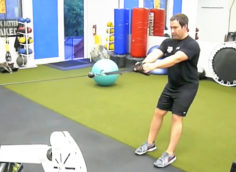Strength training requires improving your capability to produce force in a given movement. Whereas movement-speed training focuses on improving your rate of force development – that is, how quickly you can use your strength. Remember: power = strength × speed.
The heavier the load you're working against, the slower your movement becomes. So consider the principle of specificity. It states that in order to improve your explosive power, you don't just need to do exercises that involve moving against high loads; you also need to do exercises that require you to move at high SPEEDS.
And that's where the pogo movement comes in. It's basically a jump performed through the action of the ankle and foot rather than the knees. If you do it right, it'll set your calves on fire. The goal is to move fast with these. They involve very light loads (your body), but they demand that you move at high speed by minimizing ground contact time.
But these are easy to mess up, so take a look. Here's what it should and shouldn't look like. Left is good. Right is bad.
- Minimal ground contact time.
- Minimal knee flexion (knees over toes).
- To hit the ground with a more dorsiflexed foot (forefoot up).
- To hear the "pop" of your feet indicating that they're hitting the ground stiff.
- To hit the ground in a plantarflexed position (forefoot down)
- To allow for excessive knee flexion.
- To hit the ground "soft" – you're not jogging here.
This variation will place more emphasis on the lower body. Place your hands on your hips and repeatedly jump pogo style with minimal ground contact time. You should have minimal knee flexion (knees over toes) and be hitting the ground in a more dorsiflexed position. Generally, this drill should be more elastic and rhythmic in nature.




